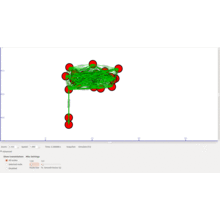How to Begin Implement Network Routing Hop Count in NS3
To implement the Network Routing Hop Count using ns3, we can adhere to these sequential steps. Hop count denotes the volume of intermediate nodes (or hops), which a packet passes through for attaining their end node within a network. We will guide you on how to get started through the following procedure:
Steps to Begin Implement Network Routing Hop Count in NS3
- Understand Hop Count
In routing protocols, hop count is a key parameter to affect:
- Latency: Additional hops can be maximized end-to-end delay.
- Path selection: Shortest path routing frequently reduces the hop count.
- Packet loss: Every single hop establishes a possible point of packet failure.
- Set Up Your Environment
Make sure that we have installed ns3 on the system and functioning properly. Set up routing protocols like AODV, OLSR, or DSDV that computes the paths depending on hop count using InternetStackHelper.
- Create the Network Topology
Example: Multi-hop Network
NodeContainer nodes;
nodes.Create(6); // Create 6 nodes
PointToPointHelper pointToPoint;
pointToPoint.SetDeviceAttribute(“DataRate”, StringValue(“1Mbps”));
pointToPoint.SetChannelAttribute(“Delay”, StringValue(“2ms”));
// Install links between nodes to form a multi-hop network
NetDeviceContainer devices;
devices.Add(pointToPoint.Install(nodes.Get(0), nodes.Get(1)));
devices.Add(pointToPoint.Install(nodes.Get(1), nodes.Get(2)));
devices.Add(pointToPoint.Install(nodes.Get(2), nodes.Get(3)));
devices.Add(pointToPoint.Install(nodes.Get(3), nodes.Get(4)));
devices.Add(pointToPoint.Install(nodes.Get(4), nodes.Get(5)));
- Install the Internet Stack
We can install the Internet stack to allow routing protocols:
InternetStackHelper internet;
AodvHelper aodv; // You can replace this with OLSR, DSDV, or other routing protocols
internet.SetRoutingHelper(aodv);
internet.Install(nodes);
Ipv4AddressHelper address;
address.SetBase(“10.1.1.0”, “255.255.255.0”);
Ipv4InterfaceContainer interfaces = address.Assign(devices);
- Generate Traffic
Make traffic among the source and destination nodes, we need to install applications.
Example: UDP Traffic
UdpEchoServerHelper echoServer(9);
ApplicationContainer serverApps = echoServer.Install(nodes.Get(5)); // Node 5 as the destination
serverApps.Start(Seconds(1.0));
serverApps.Stop(Seconds(10.0));
UdpEchoClientHelper echoClient(interfaces.GetAddress(5), 9);
echoClient.SetAttribute(“MaxPackets”, UintegerValue(1000));
echoClient.SetAttribute(“Interval”, TimeValue(Seconds(0.01))); // 10ms interval
echoClient.SetAttribute(“PacketSize”, UintegerValue(1024)); // 1KB packets
ApplicationContainer clientApps = echoClient.Install(nodes.Get(0)); // Node 0 as the source
clientApps.Start(Seconds(2.0));
clientApps.Stop(Seconds(10.0));
- Monitor Hop Count
Enable Routing Table Tracing
Record routing tables for monitoring the hop counts:
aodv.PrintRoutingTableAllAt(Seconds(5.0), Create<OutputStreamWrapper>(&std::cout));
Measure Hop Count for Packets
Observe packets and then dynamically compute the hop count with the help of callbacks:
uint32_t totalHops = 0;
uint32_t totalPackets = 0;
void PacketReceivedCallback(Ptr<const Packet> packet, const Address& src) {
// Calculate hop count based on the packet’s TTL (Time-to-Live) value
Ipv4Header header;
packet->PeekHeader(header);
uint8_t hopCount = 64 – header.GetTtl(); // Assuming initial TTL is 64
totalHops += hopCount;
totalPackets++;
std::cout << “Packet received with hop count: ” << hopCount << std::endl;
}
// Connect the callback to the receiver
Ptr<Socket> recvSocket = Socket::CreateSocket(nodes.Get(5), UdpSocketFactory::GetTypeId());
recvSocket->SetRecvCallback(MakeCallback(&PacketReceivedCallback));
- Calculate Average Hop Count
Estimate the mean hop count at the end of the simulation:
Simulator::Schedule(Seconds(10.0), [] {
if (totalPackets > 0) {
double avgHopCount = static_cast<double>(totalHops) / totalPackets;
std::cout << “Average Hop Count: ” << avgHopCount << std::endl;
} else {
std::cout << “No packets received.” << std::endl;
}
});
- Enable Tracing
ASCII and PCAP Tracing
For detailed analysis, record in-depth events using ASCII and PCAP:
AsciiTraceHelper ascii;
pointToPoint.EnableAsciiAll(ascii.CreateFileStream(“routing_hop_count.tr”));
pointToPoint.EnablePcapAll(“routing_hop_count”);
XML Animation
Envision packet routes and hops to leverage NetAnim:
AnimationInterface anim(“routing_hop_count.xml”);
- Visualize Results
- Transfer hop count data into external tools like MATLAB or Excel for comprehensive analysis.
- Monitor packet paths and routing decisions applying NetAnim.
- Experiment with Parameters
- Node Placement: Experiment with various topologies such as grid, random, or chain.
- Traffic Patterns: Modify traffic models from sources and destinations nodes.
- Routing Protocols: Equate the hop counts for routing protocols like AODV, OLSR, DSDV, and so on.
- Run the Simulation
Execute the simulation and also monitor its outcomes:
Simulator::Run();
Simulator::Destroy();
These steps will help you start the implementation, analysis and visualization of Network Routing Hop Count using NS3 environment and allow you to broaden the project to investigate advanced features.

 Click Here to watch our latest output video using NS3 simulator
Click Here to watch our latest output video using NS3 simulator  Click Here to watch our latest projects screenshots using NS3 simulator
Click Here to watch our latest projects screenshots using NS3 simulator